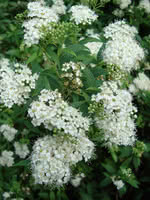Mon-Fri 9am - 5pm Mountain time
Wayfaring Tree vs White Meadowsweet
Viburnum lantana
Spiraea alba
CUSTOM GROW
NOT AVAILABLE THIS SEASON - MIGHT RETURN
Wayfaring Tree is an adaptable and reliable shrub. It is prized for its ornamental berries that can range in color from red to yellow to black. Consider getting two trees as fruiting is maximized when another Wayfaring Tree is present.
This species has a variety of uses ranging from naturalization, mass planting, borders, and privacy screens.
White Meadowsweet is a woody, deciduous shrub that begins to bloom in early summer with small white and pink flowers. Its foliage turns from a light green into an attractive golden-yellow later in the fall.
The White Meadowsweet, also known as Mead-Wort or Bride-Wort, is favored by birds and butterflies but is largely ignored by deer. They produce small brown berries in the summer, and while they are technically edible, they are not sweet and are more desired by wildlife.

